
September, 1951
Angus Shops an Industrial Giant
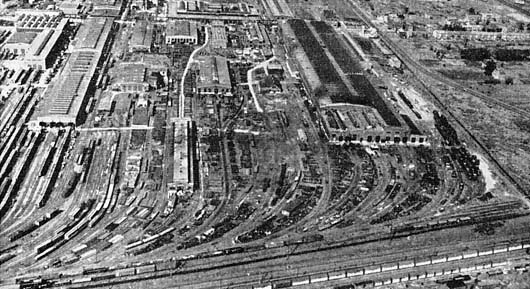
An aerial view of the Angus Shops, Montreal.
Angus Shops Montreal - the Company's enormous sprawling 200-acre main repair plant for the construction and maintenance of
the company's 87,992 units of motive power and rolling stock, is a second home for almost 7,500 men, and a virtual self-contained city.
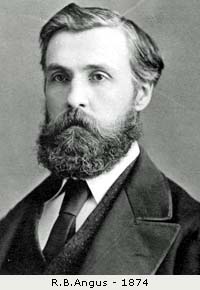 Equipped with its own power station,
hospital and ambulance service, heating plant, police force, fire brigade, lunch rooms, shop canteen service, and 160,000 square-foot
recreation centre, the shops and the men who work them are prepared to tackle any job. Handling tiny lock springs or tearing down giant
locomotives is commonplace. Like the famous U.S. Navy "Seebee" motto of World War II, the shops slogan could well read,
"The miraculous we do immediately, the impossible takes a little longer". Equipped with its own power station,
hospital and ambulance service, heating plant, police force, fire brigade, lunch rooms, shop canteen service, and 160,000 square-foot
recreation centre, the shops and the men who work them are prepared to tackle any job. Handling tiny lock springs or tearing down giant
locomotives is commonplace. Like the famous U.S. Navy "Seebee" motto of World War II, the shops slogan could well read,
"The miraculous we do immediately, the impossible takes a little longer".
From this "city" pours a constant stream of rejuvenated locomotives, coaches, car wheels, castings, switch points, and even
the nuts and bolts to hold the railway together. On the average, one engine and 88 freight and passenger cars, completely overhauled
within the vast shops, leave Angus daily to span the nation on the Company's ribbons of steel.
The shops, situated in north-east Montreal on a plateau overlooking the St. Lawrence River, were named after the late R B. Angus, one
of the original C.P.R. directorate, and a man who during his life was closely associated with the financial and economic growth of
Montreal.
Angus Shops consist of 31 main and 37 auxiliary buildings, 38 acres of shop floor space, and 50 miles of track. The buildings
comprise a locomotive repair shop, four passenger car repair shops, two large freight car repair buildings, a cast iron wheel foundry,
a general castings foundry, a frog and track switch repair shop, a bolt and nut manufacturing shop, a large blacksmith shop, a truck
repair shop, a car metal working machine shop, a large wood mill, an electrical repair shop, a cabinet and varnishing shop, a brass
machine and tinsmithing shop, an upholstery repair shop, a large general stores, plant hospital, police building, modern general office,
and administration building.
There are also a test and inspection department, and open freight car repair tracks accommodating some 1,000 cars. A new modern scrap
and reclaim dock which handles 430 tons of material daily, a shot blast building for cleaning steel equipment, and a large locomotive
boiler repair shop have been constructed since the war's end.
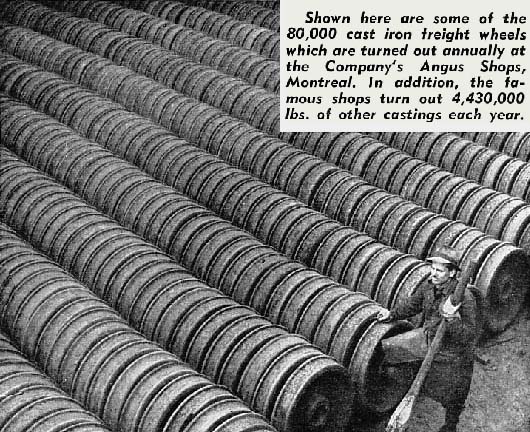
A "monster" of this size usually has a large appetite, and Angus Shops lives up to this belief. Annually it polishes off
a meal of 40,000 tons of steel and 16,800,000 feet of lumber, finishing up with a dessert of 18,000,000 kilowatt hours of electricity and
13,200,000 cubic feet of gas. A yearly drink of 33,600,000 cubic feet of water quenches its thirst. This is the material required to keep
Angus producing the goods, which like blood, circulate along the rail arteries of Canada, giving life to the nation.
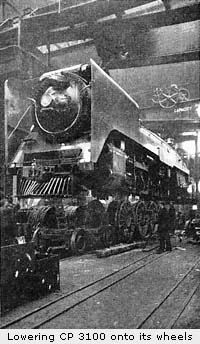 From this hungry monster, 7,200 shop
personnel and the 300 apprentices in training, who yearly receive $25,000,000 in salaries, coax a prodigious output. Annually they
manufacture nearly 80,000 iron freight car wheels, 4,430,000 pounds of castings, 5,475 tons of material from the blacksmith shop, and
985,000 bolts, pins, nuts, and rivets. From this hungry monster, 7,200 shop
personnel and the 300 apprentices in training, who yearly receive $25,000,000 in salaries, coax a prodigious output. Annually they
manufacture nearly 80,000 iron freight car wheels, 4,430,000 pounds of castings, 5,475 tons of material from the blacksmith shop, and
985,000 bolts, pins, nuts, and rivets.
The shops are mainly used for the maintenance of locomotives, passenger equipment, and freight cars. Approximately 30 classified
locomotive repairs can be turned out monthly at the locomotive shop.
Before the C.P.R. started its gradual conversion to diesel motive power, five new steam locomotives were constructed there each month.
Approximately 1,000 passenger cars are shopped annually at the passenger car shops and in addition there are facilities for the output of
10 new passenger cars per month. The freight car shops, one each for both wooden and steel equipment, have a capacity for 100 shop repairs
per day and 14 new cars, and together with the freight repair tracks, now turn out around 21,000 freight car repairs per annum. Last year
88 cars of all types received repairs there daily.
Among the jobs done to these cars were conversion work, modernization, improvements to brakes, lighting, springing, and trucks.
Last year automobile freight cars rolled into Angus to be fitted with wider, staggered, doors. The reason: autos, since the war's
end, have grown wider and longer, forcing the railway, like many garage owners, to make alterations to keep abreast of the moods of car
designers. All such operations, dispatched with the efficiency of a top-flight surgeon, are considered routine. But occasionally the
supreme test comes along.
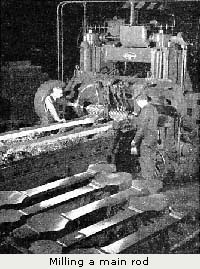 In 1948, during a routine annual
inspection, a flaw was discovered in the after crank web of the 10,000-ton Canadian Pacific immigrant vessel Beaverbrae, just as it was to
sail from Montreal prior to the harbour's winter freeze-up. Winter cold was setting in fast and if the ship was to leave port at all it
would have to do so quickly. In 1948, during a routine annual
inspection, a flaw was discovered in the after crank web of the 10,000-ton Canadian Pacific immigrant vessel Beaverbrae, just as it was to
sail from Montreal prior to the harbour's winter freeze-up. Winter cold was setting in fast and if the ship was to leave port at all it
would have to do so quickly.
Angus Shops workers were equal to the task. By working night and day, the shops forged a 5,200 pound piece of steel and machined it to
strengthen the flawed shaft and shut off one piston of the diesel engine. Fourteen days later the block was delivered from Angus and the
Beaverbrae sailed, the last ship to leave harbour that winter.
The vital role played by the shops in this emergency created no precedent, for Angus Shops played an even more imposing role during the
national emergency of World War II.
At the outbreak of hostilities, the Canadian Pacific Railway placed the facilities of the shops at the disposal of the Canadian
government for utilization of all available space, equipment, and facilities in the prosecution of the
war.
In June, 1940, the first order for the construction of 18-ton Valentine tanks was placed with Angus
Shops by the Department of Munitions and Supply, acting on behalf of the Canadian Government. In all, over 1,400 of these tanks were
constructed.
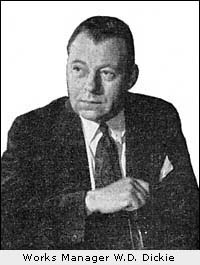 In addition to this job, orders were
placed with the shops for the building of marine engines to power Canadian naval frigates and corvettes, range finders for naval guns,
delicate ASDIC (Also known as Sonar. It is claimed that the name ASDIC is derived from "Anti-Submarine Detection Investigation
Committee", but there is no trace of such a committee in the British Admiralty's archives.) equipment for searching out German
U-boats under the swelling surface of the Atlantic, and miles of lathe bed to be used by other Canadian war plants for machine tool
manufacture. In addition to this job, orders were
placed with the shops for the building of marine engines to power Canadian naval frigates and corvettes, range finders for naval guns,
delicate ASDIC (Also known as Sonar. It is claimed that the name ASDIC is derived from "Anti-Submarine Detection Investigation
Committee", but there is no trace of such a committee in the British Admiralty's archives.) equipment for searching out German
U-boats under the swelling surface of the Atlantic, and miles of lathe bed to be used by other Canadian war plants for machine tool
manufacture.
While this feverish activity proceeded, a Red Cross blood donor clinic was set up in the shops' fully equipped hospital for donations
in connection with the Society's war services.
This attitude of willingness to tackle any job is reflected in the motto of the man who runs Angus Shops, W.D. Dickie, works manager, a
52-year-old native Montrealer. The motto runs, "Don't say it can't be done, for chances are you'll rue it, for some darn fool will
come along and he will surely do it!"
Mr. Dickie joined the Canadian Pacific Railway in 1915 as an apprentice at Glen Yards, Westmount, interrupting his training to serve
overseas in World War I with the First Tank Battalion. In the C.P.R.'s service he has held posts in Winnipeg, Moose Jaw, and Calgary,
until 1940 when he was transferred back to Montreal. Here he had a good chance to remember his armoured corps days of World War I when
tank production at Angus in 1940 fell under his jurisdiction.
A big forthright man, with a direct manner of speaking, Dave Dickie looks ready to handle any job which might come to the C.P.R.'s
Angus Shops.
This Spanner News article is copyright 1951 by Canadian Pacific Railway and is reprinted here with their
permission. All photographs, logos, and trademarks are the property of the Canadian Pacific Railway Company.

|